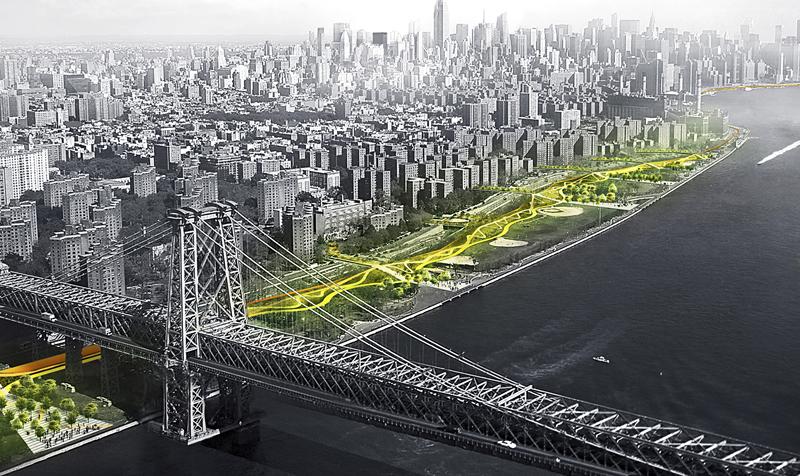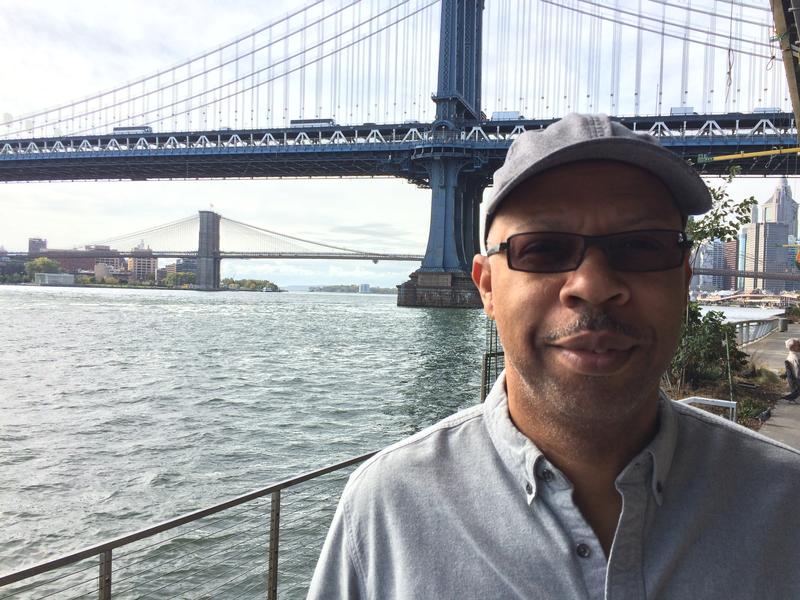
In June 2014 — 18 months after Sandy battered the region — Mayor Bill de Blasio joined state and federal officials outside a public housing complex on the Lower East Side to announce an ambitious plan to protect the neighborhood against The Next Big One. Over the previous year, The federal government had brought top engineers and architects together to pitch resiliency projects and was going to agree to fund some of those plans. The big winner for the city was called "The Big U" — a 10-mile U-shaped barrier from 57th Street on the west side, down the battery and up the east side to 42nd Street. It was supposed to feature public art space and stunning new parkland.
The feds agreed to kick in $335 million for the first phase, a roughly two-mile stretch along the Lower East Side. That portion of the project — called the East Side Coastal Resiliency Project — is basically a berm with plantings and recreation space that will act as a barrier during a storm and a stunning new park the rest of the time. The Bjarke Ingels Group, a renowned Danish architecture firm, cam up with the idea. They originally wanted to build three new walkways over the FDR Drive and to enhance two existing bridges, all to improve community access to the new park.
Five years after Sandy, the plan — perhaps the most high-profile of numerous resiliency projects to protect the city and region — is still just lines on paper. The groundbreaking has been delayed by at least 18 months, and already some of the amenities promised to the community have been removed to cut costs.
“Right now, I don’t feel any more prepared than we were five years ago,” said Trever Holland, who lives in an affordable housing complex in the densely packed neighborhood. “We know what can happen now and the fact that we don’t even have temporary solutions is a bit troublesome,” Holland said.
When Sandy hit, Holland watched the floodwaters burst into his building's lobby. Then he saw sparks and heard an explosion before the power went out. Now, he sits on a joint Community Board 3 and Community Board 6 waterfront task force and has been following the progress of the Big U since it was announced. Like others in the area he spent more than a year seeing public presentations promising a groundbreaking in June 2017. Then, suddenly, that date changed to "TBD" – to be determined. The city now says it will break ground in 2019.
The delay isn’t the only concern. The city recently scrapped plans to build the new bridges over the FDR Drive that would have connected public housing residents to the waterfront.
“We see them actually scaling back in the promises they made to community members,” said Ceci Pineda, resiliency training and policy coordinator at the Good Old Lower East Side, or GOLES, a community advocacy organization.
The city’s chief resilience officer, Daniel Zarrilli, said access to the park is still important to the city. But the city, which is kicking in more than $400 million for the Lower East Side project, has to live within a budget.
As for the delay, Zarrilli said the park-berm is unique — a massive project that combined infrastructure with open-space, all in a dense, urban environment along the water.
“We’ve been working really extensively with the community in order to get this to the right project we can implement,” Zarrilli said.
He said the city is moving as quickly as possible given the urgency of climate change.
Zarrilli said the city has made progress on a number of resiliency projects started after Sandy like the Rockaway boardwalk and stone barriers in Sea Gate.
Still, a number of ideas and projects are unfunded. There’s no clear pot of money to pay for other parts of the “Big U” system of protections that was intended to hug the bottom half of Manhattan.
“The ‘Big U’ might actually be just half a 'J,'” quipped City Councilman Mark Treyger, the chairman of the City Council’s recovery and resiliency committee.
Treyger says the city hasn’t made as much progress as it should in the five years since the storm to protect property and lives.
“When people say ‘Are we better prepared?’ — that’s a loaded question," he said. "We have studies now. We have many great studies and great pictures. But we don’t have the funds to complete these projects."
This report is produced in collaboration with Peril and Promise, a public media initiative on the human impact of climate change from WNET.

